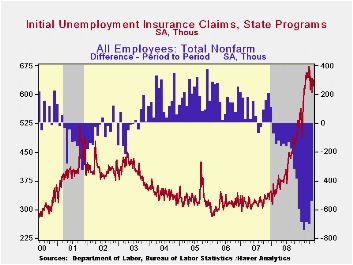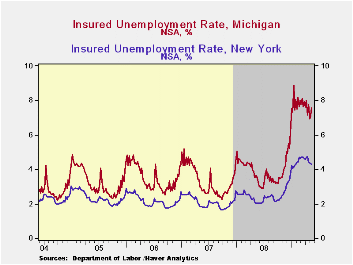 Global| Jun 04 2009
Global| Jun 04 2009U.S. Initial Unemployment Insurance Claims Slip
by:Tom Moeller
|in:Economy in Brief
Summary
The labor market is neither worsening nor improving significantly. It just remains quite soft. The latest indication of this is last week's slip in initial claims for unemployment insurance by 4,000 to 621,000 from an upwardly revised [...]

The labor market is neither worsening nor improving significantly. It just remains quite soft. The latest indication of this is last week's slip in initial claims for unemployment insurance by 4,000 to 621,000 from an upwardly revised level of 625,000. Initial claims are down from their March peak of 674,000. However, the four-week average of claims, which smoothes out some of the volatility in the weekly numbers, rose slightly to 631,250. Though that was near the lowest level since mid-February it was up by two-thirds from the year ago level. The Consensus expectation was for 620,000 claims last week.
The Labor Department indicated that the largest increases in initial claims for the week ending May 23 were in Illinois (+3,881), Iowa (+2,312), South Carolina (+1,792), Texas (+1,548), and Wisconsin (+1,464), while the largest decreases were in North Carolina (-3,952), Michigan (-2,812), Ohio (-2,158), Tennessee (-2,053), and Connecticut (-1,320).
Continuing claims for unemployment insurance, which provide an indication of workers' ability to find employment remained near the record high of 6,735,000, more than twice the year ago level. Further indicating that the job market remains weak, the four-week average of continuing claims also rose to another record of 6,687,500. The series dates back to 1966.
Another indication of the labor market's softness was that the insured unemployment rate held at 5.0% for the third consecutive week. That level was more than double last May and the highest level since 1983. During the last ten years there has been a 93% correlation between the level of the insured unemployment rate and the overall rate of unemployment published by the Bureau of Labor Statistics.Clearly, the latest weekly figure understates labor market distress in some states.
The highest insured unemployment rates in the week ending May 16 were in Michigan (7.6 percent), Oregon (7.1), Puerto Rico (6.7), Nevada (6.4), Pennsylvania (6.2), Wisconsin (5.9), California (5.5), Arkansas (5.4), Idaho (5.4), and North Carolina (5.4). Even in states where the insured unemployment rate was relatively low such as Massachusetts (5.0), New York (4.3), Florida (3.9) Georgia (3.7), Texas (2.9), and Virginia (2.6), the level was double that of one year ago.
The unemployment insurance claims data is available in Haver's WEEKLY database and the state data is in the REGIONW database.Yesterday's testimony by Fed Chairman Ben S. Bernanke can be found here.
| Unemployment Insurance (000s) | 05/30/09 | 05/23/09 | 05/16/09 | Y/Y | 2008 | 2007 | 2006 |
|---|---|---|---|---|---|---|---|
| Initial Claims | 621 | 625 | 636 | 67.8% | 420 | 321 | 313 |
| Continuing Claims | -- | 6,735 | 6,750 | 117.6% | 3,342 | 2,552 | 2,459 |
Tom Moeller
AuthorMore in Author Profile »Prior to joining Haver Analytics in 2000, Mr. Moeller worked as the Economist at Chancellor Capital Management from 1985 to 1999. There, he developed comprehensive economic forecasts and interpreted economic data for equity and fixed income portfolio managers. Also at Chancellor, Mr. Moeller worked as an equity analyst and was responsible for researching and rating companies in the economically sensitive automobile and housing industries for investment in Chancellor’s equity portfolio. Prior to joining Chancellor, Mr. Moeller was an Economist at Citibank from 1979 to 1984. He also analyzed pricing behavior in the metals industry for the Council on Wage and Price Stability in Washington, D.C. In 1999, Mr. Moeller received the award for most accurate forecast from the Forecasters' Club of New York. From 1990 to 1992 he was President of the New York Association for Business Economists. Mr. Moeller earned an M.B.A. in Finance from Fordham University, where he graduated in 1987. He holds a Bachelor of Arts in Economics from George Washington University.






